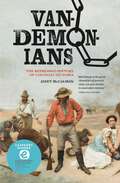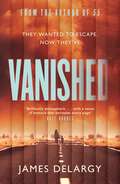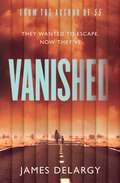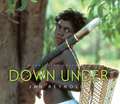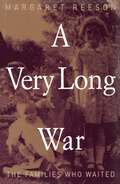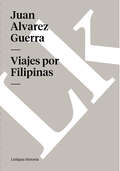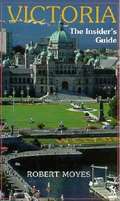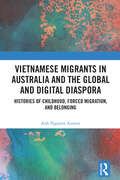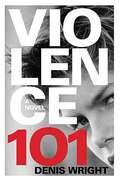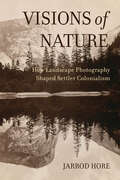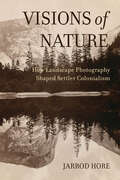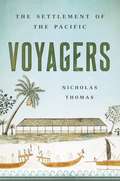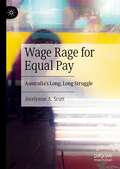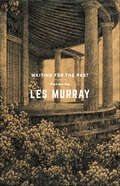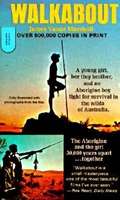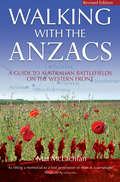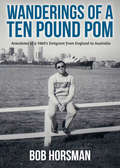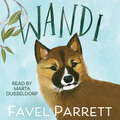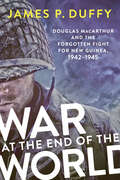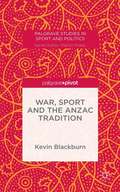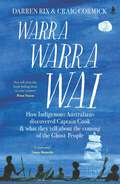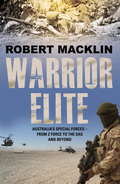- Table View
- List View
Vandemonians: The Repressed History of Colonial Victoria
by Janet McCalmanIt was meant to be 'Victoria the Free', uncontaminated by the Convict Stain. Yet they came in their tens of thousands as soon as they were cut free or able to bolt. More than half of all those transported to Van Diemen's Land as convicts would one day settle or spend time in Victoria. There they were demonised as Vandemonians. Some could never go straight; a few were the luckiest of gold diggers; a handful founded families with distinguished descendants. Most slipped into obscurity. Burdened by their pasts and their shame, their lives as free men and women, even within their own families, were forever shrouded in secrets and lies. Only now are we discovering their stories and Victoria's place in the nation's convict history. As Janet McCalman examines this transported population of men, women and children from the cradle to the grave, we can see them not just as prisoners, but as children, young people, workers, mothers, fathers and colonists. From the author of Struggletown and Journeyings, this rich study of the lives of unwilling colonisers is an original and confronting new history of our convict past-the repressed history of colonial Victoria.
Vanished
by James DelargyFrom the groundbreaking author of 55 comes an extraordinary new thriller... The Kane family, Lorcan, Naiyana and their young son, relocate from Perth to Kallayee, an abandoned mining town in the Great Victoria Desert to start over again, free from their chequered past. The town seems like the perfect getaway: Peaceful. Quiet. Remote. Somewhere they won&’t be found. But life in Kallayee isn&’t quite as straightforward as they hope. There are noises in the earth, mysterious shadows and tracks in the dust as if the town is coming back to life. But the family can&’t leave. No one can talk sense into them. And now, no one can talk to them at all. They&’ve simply vanished. Now it's up to Detective Emmaline Taylor to find them… before it&’s too late. ** Praise for Vanished ** &‘Delargy manages to turn the wide-open deserted Outback into something intensely claustrophobic and chilling&’ Russ Thomas &‘Intense, insightful and impossible to put down, Vanished is a gripping tale of greed and betrayal, burning with tension under a harsh Australian sun&’ Caz Frear 'Powered through this in two sittings. Vanished ratchets up the tension page after page, playing out in a perfect isolated setting with such a claustrophobic feel, and so vividly painted you could step right in' Rob Scragg 'There is menace on every page of this atmospheric thriller. An abandoned mining town in the Australian outback is the desolate - almost surreal - backdrop to a tale of a disintegrating family. Perfect for fans of The Dry' Jo Furniss, author of the Amazon Charts best-seller All The Little Children ** Praise for 55 ** &‘A pulse-pounding psycho-thriller . . . splendidly-engineered plot and a masterly sense of pace allied to a haunting background make for a powerful debut&’ Crime Time &‘A clever concept for this fast-moving debut, fleshed out with a sympathetic hero haunted by grim memories&’ Sunday Times Crime Club &‘Brilliantly atmospheric…with a sense of menace that pervades every page. Even more impressive than 55&’ Kate Rhodes 'Fabulously atmospheric, a splendid slice of outback noir for fans of Jane Harper. The intricately woven plot sucks you into a hostile world and keeps you sweating until the final page' Adam Southward 'A gripping race through the bleak Australian outback to find a missing family: Vanished captivated and intrigued me from page one' Louisa De Lange 'If you liked the Dry you will like this' 'I enjoy a good psychological thriller and this was up there with the best' &‘I loved this book from start to finish . . . the ending is still on my mind today&’ &‘A real page-turner. Gets a grip on you from the start. Best book I&’ve read in years!&’ &‘I found it impossible to tear myself away from this small, isolated community as they stumbled into a territory more hostile and unpredictable than any place on earth. LOVED IT&’
Vanished
by James DelargyFrom the groundbreaking author of 55 comes an extraordinary new thriller... Lorcan and Naiyana are desperate to move their young family far away from the hustle and bustle of modern city life.The abandoned town of Kallayee seems like the perfect getaway: no one has lived there for decades. It will be peaceful. Quiet. Secure.But life in Kallayee isn&’t quite as straightforward as they hope. Lights flicker at night. Car tracks appear in the dust even when the family hasn&’t driven anywhere. And six-year-old Dylan is certain he can hear strange sounds.Lorcan and Naiyana refuse to leave. No one can talk sense into them.And now, no one can talk to them at all.They&’ve simply vanished.Praise so far for Vanished: &‘Delargy manages to turn the wide-open deserted Outback into something intensely claustrophobic and chilling&’ Russ Thomas * * * Readers love 55 by James Delargy* * * &‘A pulse-pounding psycho-thriller . . . splendidly-engineered plot and a masterly sense of pace allied to a haunting background make for a powerful debut&’ Crime Time &‘A clever concept for this fast-moving debut, fleshed out with a sympathetic hero haunted by grim memories&’ Sunday Times Crime Club &‘Brilliantly atmospheric…with a sense of menace that pervades every page. Even more impressive than 55&’ Kate Rhodes 'Fabulously atmospheric, a splendid slice of outback noir for fans of Jane Harper. The intricately woven plot sucks you into a hostile world and keeps you sweating until the final page' Adam Southward 'A gripping race through the bleak Australian outback to find a missing family: Vanished captivated and intrigued me from page one' Louisa De Lange 'If you liked the Dry you will like this' 'I enjoy a good psychological thriller and this was up there with the best' &‘I loved this book from start to finish . . . the ending is still on my mind today&’ &‘A real page-turner. Gets a grip on you from the start. Best book I&’ve read in years!&’ &‘I found it impossible to tear myself away from this small, isolated community as they stumbled into a territory more hostile and unpredictable than any place on earth. LOVED IT&’
Vanishing Cultures: Down Under (Vanishing Cultures)
by Jan ReynoldsIn this series of seven books, photojournalist Jan Reynolds documents the distinctive cultures and climates of indigenous peoples.Amprenula, a young Tiwi girl from an island off the Australian coast, gathers food with her mother. Amprenula lives closely with the land, just as her people have done for thousands of years, taking only what they need from the forest and the ocean around them. For the Tiwi and other Aborigines, the land is sacred. It connects them with their ancestors and the beginning of creation. As Amprenula combs through the forests and mangrove swamps, she is proud to travel along the same paths, sharing the same land, as her ancestors from centuries ago.
Very Long War: The Families Who Waited
by Margaret ReesonA Very Long War is about the experiences of the families of men missing in the New Guinea islands during World War 2, many of whom never returned. When Japan entered the Pacific war, the Australian Government evacuated all Australian women and children from the Territory of New Guinea. The women found themselves suddenly alone and solely responsible for the welfare of their families. Back in Australia, they were cut off from letters and reliable news for three and a half years. Rumours abounded, adding to their trauma and anxiety. Like the families of POWs, they lived in a limbo of waiting. For many of them, the effects of the mystery and the trauma have continued to the present day. A Very Long War is a calm, respectful narrative, beautifully told, never over-written. Its poignant, sometimes shocking stories are treated with insight and restraint. Through the voices of those who provided oral testimony, it echoes the common condition of all people struggling to deal with trauma and loss.
Viajes por Filipinas
by Juan Álvarez GuerraThis book was written in 1871 by order of the Governor General of the Philippines, Rafael Izquierdo. The work includes relevant ethnographic, geographic, historical, and political data.
Victoria: The Insider's Guide
by Robert MoyesAll the must-see, must-visit places in the beautiful "City of Gardens." Victoria, nestled jewel-like at the southern tip of Vancouver Island, offers a legion of transient pleasures to the visitor and more abiding satisfactions for permanent residents. Most immediately apparent is the superb setting. Bounded by water on three sides, with marine vistas that culminate in the snow-capped peaks of the Olympic Mountains across the Strait of Juan de Fuca, Victoria has grown up amidst a gently rolling landscape that never lacks for pastoral charm. With its balmy, Mediterranean climate, a pedestrian-oriented downtown whose nineteenth-century buildings are attractively built to a human scale, and a full range of sophisticated urban amenities, Victoria is the quintessential island retreat. The city can be a little bit smug, perhaps, but the locals are always eager to share their beautiful surroundings and easy-going lifestyle with tourists and recent arrivals alike.
Vietnamese Migrants in Australia and the Global Digital Diaspora: Histories of Childhood, Forced Migration, and Belonging
by Anh Nguyen AustenThrough oral histories, memoirs, and Facebook posts of Vietnamese adults who entered Australia as children after the Vietnam War (and Vietnamese refugees, war orphans, and children of refugees) this book provides insight into the memories of forced migrant childhoods and histories, as well as the complexities of national and transnational identity and belonging in digital diaspora. As war and displacement compounds the need for creating communities and histories for cultural continuity, this book is a history about childhood and migration for the Vietnamese diaspora of refugees, adoptees, and second generation in Australia and their connectedness to a global and digital diaspora. Using Facebook as a digital archive for historical research, Vietnamese Migrants in Australia and the Global Digital Diaspora presents new methods for the study of what Nguyen Austen proposes as a new area of digital diaspora studies for interdisciplinary research about real and digital life in the humanities and social sciences. As a contemporary digital diaspora study of Vietnamese forced child migrants from 1975 to the present, this book contains a mixed-methods historical analysis of the impact of war and displacement on memories of childhood. This book presents an innovative history of the national, transnational, digital, and contemporaneous lives of Vietnamese child migrants, which will make a significant contribution to the discourse on transnational childhood, migration, and belonging for refugees and migrants in the twenty-first century.
Violence 101
by Denis WrightFourteen year-old Hamish doesn't simply do terrible things, he is committed to the belief that violence is the solution to the obstacles in life. But Hamish is also extremely smart, and extremely self-aware. And he considers everyone around him-the other institutionalized boys, his teachers and wardens, the whole world-as sheep, blindly following society's rules, unaware of what really dictates our existence. Hamish's heroes, like Alexander the Great, understood that violence drives us all. Through mesmerizing journal entries, Violence 101 paints a disturbing yet utterly compelling picture of an extremely bright, extremely misguided adolescent who must navigate a world that encourages aggressive behavior at every turn, but then struggles to help a young man who doesn't know where to draw the line between appropriate and inappropriate behavior. .
Visions of Nature: How Landscape Photography Shaped Settler Colonialism
by Dr. Jarrod HoreVisions of Nature revives the work of late nineteenth-century landscape photographers who shaped the environmental attitudes of settlers in the colonies of the Tasman World and in California. Despite having little association with one another, these photographers developed remarkably similar visions of nature. They rode a wave of interest in wilderness imagery and made pictures that were hung in settler drawing rooms, perused in albums, projected in theaters, and re-created on vacations. In both the American West and the Tasman World, landscape photography fed into settler belonging and produced new ways of thinking about territory and history. During this key period of settler revolution, a generation of photographers came to associate "nature" with remoteness, antiquity, and emptiness, a perspective that disguised the realities of Indigenous presence and reinforced colonial fantasies of environmental abundance. This book lifts the work of these photographers out of their provincial contexts and repositions it within a new comparative frame.
Visions of Nature: How Landscape Photography Shaped Settler Colonialism
by Dr. Jarrod HoreVisions of Nature revives the work of late nineteenth-century landscape photographers who shaped the environmental attitudes of settlers in the colonies of the Tasman World and in California. Despite having little association with one another, these photographers developed remarkably similar visions of nature. They rode a wave of interest in wilderness imagery and made pictures that were hung in settler drawing rooms, perused in albums, projected in theaters, and re-created on vacations. In both the American West and the Tasman World, landscape photography fed into settler belonging and produced new ways of thinking about territory and history. During this key period of settler revolution, a generation of photographers came to associate "nature" with remoteness, antiquity, and emptiness, a perspective that disguised the realities of Indigenous presence and reinforced colonial fantasies of environmental abundance. This book lifts the work of these photographers out of their provincial contexts and repositions it within a new comparative frame.
Vociferate
by Emily SunThe poems in Emily Sun's debut poetry collection Vociferate were inspired by diasporic-Asian feminist writers. Like these writers, Emily resists both Eurocentric and patriarchal tropes as she explores the complexities of national and transnational identities, reflects upon the concept of belonging, and questions what it means to be Asian-Australian.
Voyagers: The Settlement of the Pacific
by Nicholas ThomasAn award-winning scholar explores the sixty-thousand-year history of the Pacific islands in this dazzling, deeply researched account. The islands of Polynesia, Melanesia, and Micronesia stretch across a huge expanse of ocean and encompass a multitude of different peoples. Starting with Captain James Cook, the earliest European explorers to visit the Pacific were astounded and perplexed to find populations thriving thousands of miles from continents. Who were these people? From where did they come? And how were they able to reach islands dispersed over such vast tracts of ocean?In Voyagers, the distinguished anthropologist Nicholas Thomas charts the course of the seaborne migrations that populated the islands between Asia and the Americas from late prehistory onward. Drawing on the latest research, including insights gained from genetics, linguistics, and archaeology, Thomas provides a dazzling account of these long-distance migrations, the seagoing technologies that enabled them, and the societies they left in their wake.
Wage Rage for Equal Pay: Australia’s Long, Long Struggle
by Jocelynne A. ScuttThis book makes a major contribution to the continuing legal and historical struggle for equal pay in Australia, with international references, including Canada, the UK and US. It takes law, history and women’s and gender studies to analyse and recount campaigns, cases and debates. Industrial bodies federally and around Australia have grappled with this issue from the early-twentieth century onwards. This book traces the struggle through the decades, looking at women's organisations activism and demands, union ‘pro’ and ‘against’ activity, and the 'official' approach in tribunals, boards and courts.
Waiting for the Past: Poems
by Les MurrayA new collection of poems from Les Murray that renews and transforms the contemporary world through languageIn Waiting for the Past, Les Murray employs his molten sense of language to renew and transform our experience of the world. With quicksilver verse, he conjures his rural past, the life of the poor dairy boy in Australia, as he simultaneously feels the steady tug of aging, of time pulling him back to the present. Here, syntax, sense, and sound combine with such acrobatic grace that his poems render the familiar into the unknown, the unknown into the revelatory. Whether Murray is writing about a boy on a walkabout hiding from grief, a sounding whale “spilling salt rain,” or leaves that “tread on the sky,” the great Australian poet’s sense of wonder, his ear for the everyday, his swiftness of thought, are everywhere in these pages. As Derek Walcott said of Murray’s work, “There is no poetry in the English language now so rooted in its sacredness, so broad-leafed in its pleasures, and yet so intimate and conversational.”
Walkabout
by James Vance MarshallNovel that focuses on the journey of a two children in Australia but also examines the interactions between Western civilization and the Aborigine peoples of the world.
Walking with the ANZACS: The authoritative guide to the Australian battlefields of the Western Front
by Mat McLachlan'[Mat McLachlan's] knowledge of the front is comprehensive' - Sydney Morning HeraldA complete guide to the Australian battlefields of the Western Front 1916-18.Walking with the ANZACs aims to become the new essential companion for Australians visiting the Western Front. Each of the 14 most important Australian battlefields is covered with descriptions of the battles and Australia?s involvement in it.The book presents a well-illustrated walking tour across the old battlefields. The tours are designed along easily accessible walking routes and show readers battlefield landmarks that still exist, memorials to the men who fought there and the cemeteries where many of them still lie. In this way the visitor will see the battlefield in much the same way as the original ANZACs did, and gain a greater appreciation of the site?s significance. Importantly, the tours are not written for military experts, but for ordinary visitors whose military knowledge may be limited.More than just a handy travel guide, Walking with the ANZACs is an absorbing read for armchair travellers and students of the First World War who may not have had the opportunity to visit the battle fields and walk in the footsteps of the first ANZACs.
Wanderings of a Ten Pound Pom: Anecdotes Of A 1960's Emigrant From England To Australia
by Bob HorsmanWanderings of a Ten Pound Pom is about an English emigrant to Australia beginning almost 50 years ago in 1966, until his marriage in 1977. The stories revolve around his work as an electrician in this new country and his travels throughout the world during that time. Those travels include visits to 32 countries with over a hundred locations. There are some funny moments, some are adventurous and some are more than a little embarrassing. Some are serious and some are light-hearted. An entertaining read, for the bus or the train, over a coffee or at bedtime. Bob Horsman's writing of those times has been almost as enjoyable for him as living them. It is his hope that the reading of these anecdotes will do the same for you.
Wandi
by Favel ParrettA young cub is snatched from his family and home by a giant eagle, then dropped, injured and alone, in a suburban garden. This is where he meets his first Human, and begins his long journey to becoming the most famous dingo in the world. He will never see his mountain home again, or his family. But it is his destiny to save alpine dingoes from extinction, and he dreams of a time when all cubs like him can live in the wild in safety, instead of facing poison and bullets and hatred. A children's literary classic in-the-making from one of Australia's most-loved authors is brought to life by Helpmann and AACTA award-winning actress Marta Dusseldorp.
War at the End of the World
by James P. DuffyA harrowing account of an epic, yet nearly forgotten, battle of World War II--General Douglas MacArthur's four-year assault on the Pacific War's most hostile battleground: the mountainous, jungle-cloaked island of New Guinea.One American soldier called it "a green hell on earth." Monsoon-soaked wilderness, debilitating heat, impassable mountains, torrential rivers, and disease-infested swamps--New Guinea was a battleground far more deadly than the most fanatical of enemy troops. Japanese forces numbering some 600,000 men began landing in January 1942, determined to seize the island as a cornerstone of the Empire's strategy to knock Australia out of the war. Allied Commander-in-Chief General Douglas MacArthur committed 340,000 Americans, as well as tens of thousands of Australian, Dutch, and New Guinea troops, to retake New Guinea at all costs.What followed was a four-year campaign that involved some of the most horrific warfare in history. At first emboldened by easy victories throughout the Pacific, the Japanese soon encountered in New Guinea a roadblock akin to the Germans' disastrous attempt to take Moscow, a catastrophic setback to their war machine. For the Americans, victory in New Guinea was the first essential step in the long march towards the Japanese home islands and the ultimate destruction of Hirohito's empire. Winning the war in New Guinea was of critical importance to MacArthur. His avowed "I shall return" to the Philippines could only be accomplished after taking the island.In this gripping narrative, historian James P. Duffy chronicles the most ruthless combat of the Pacific War, a fight complicated by rampant tropical disease, violent rainstorms, and unforgiving terrain that punished both Axis and Allied forces alike. Drawing on primary sources, War at the End of the World fills in a crucial gap in the history of World War II while offering readers a narrative of the first rank. From the Hardcover edition.
War, Sport and the Anzac Tradition (Palgrave Studies in Sport and Politics)
by Kevin BlackburnWar, Sport and the Anzac Tradition.
War, Sport and the Anzac Tradition (Palgrave Studies in Sport and Politics)
by Kevin BlackburnCommemoration of war is done through sport on Anzac Day to remember Australia's war dead. War, Sport and the Anzac Tradition traces the creation of this sporting tradition at Gallipoli in 1915, and how it has evolved from late Victorian and Edwardian ideas of masculinity extolling prowess on the sports field as fostering prowess on the battlefield.
Warra Warra Wai: How Indigenous Australians discovered Captain Cook, and what they tell about the coming of the Ghost People
by Craig Cormick Darren RixFor the first time, the First Nations story of Cook&’s arrival, and what blackfellas want everyone to know about the coming of Europeans Both 250 years late and extremely timely, this is an account of what First Nations people saw and felt when James Cook navigated their shores in 1770. We know the European story from diaries, journals and letters. For the first time, this is the other side. Who were the people watching the Endeavour sail by? How did they understand their world and what sense did they make of this strange vision? And what was the impact of these first encounters with Europeans? The answers lie in tales passed down from 1770 and in truth-telling of the often more brutal engagements that followed. Darren Rix (a Gunditjmara-GunaiKurnai man, radio reporter and Archie Roach&’s nephew) and his co-author Craig Cormick travelled to all the places on the east coast that were renamed by Cook, and listened to people&’s stories. With their permission, these stories have been woven together with the European accounts and placed in their deeper context: the places Cook named already had names; the places he &‘discovered&’ already had peoples and stories stretching back before time; and although Cook sailed on, the empire he represented impacted the people&’s lives and lands immeasurably in the years after. &‘Warra Warra Wai&’ was the expression called to Cook and his crew when they tried to make landfall in Botany Bay. It has long been interpreted as &‘Go away&’, but is perhaps more accurately translated as &‘You are all dead spirits&’. In adding the First Nations version of these first encounters to the story of Australian history, this is a book that will sit on Australian shelves alongside Cook&’s Journals, Dark Emu and The Fatal Shore as one of our foundational texts.
Warrior Elite: Australia's special forces Z Force to the SAS intelligence operations to cyber warfare
by Robert MacklinA compelling account of Australia's intelligence organisations and special forces - from the early days of the commandos during World War II through to the SAS of today and the cyber wars of the future. From the co-author of SAS Sniper.Warrior Elite is a unique and compelling account of Australia's special forces and intelligence operations - ranging from the early special forces of World War II to the establishment and development of the SAS and Commando Regiments as the elite fighters of today, and from the Australian Security Intelligence Service to the Australian Signals Directorate and ASIO. It is an authoritative, gripping and thoroughly up-to-date account of both the history and current state of our special forces and intelligence bodies - and gives a unique glimpse into the warfare of the future. Our future.Robert Macklin has conducted dozens of exclusive interviews and uncovered incredible, daring and sometimes heartbreaking stories of the elite troops that guard our nation and engage in secret operations around the world. He has had significant cooperation from numerous sources within the special forces and the various intelligence agencies.Both thoroughly researched and colourfully written, Warrior Elite will attract the reader of action memoirs as well as those interested in broader military history and espionage.
Warriors: In the Crossfire
by Nancy Bo FloodIn the South Pacific during World War II, Joseph takes responsibility for his people. On the island of Saipan, the war is a distant idea for Joseph.
